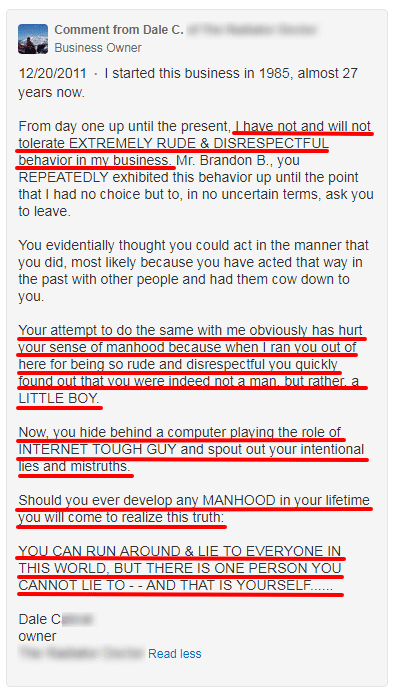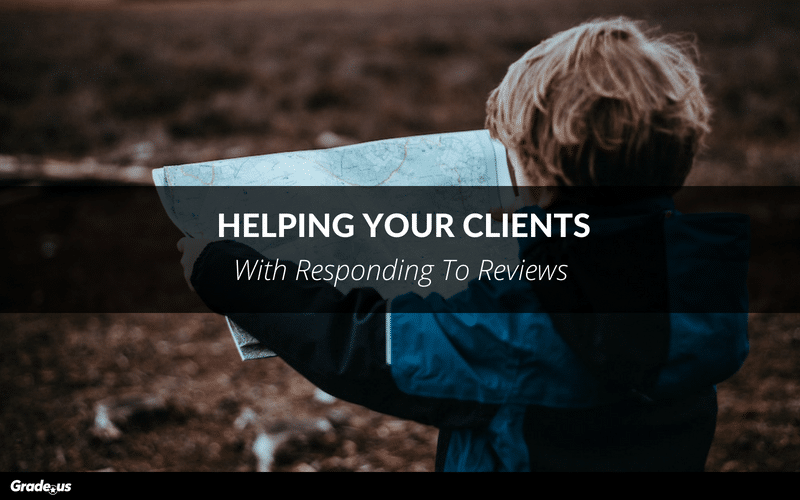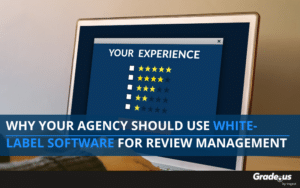Picture this.
You've mapped out a review strategy for your clients. Responding to online reviews isn't always easy or pleasant, but you know how to turn a disaster into a win.
If your clients follow your lead, they succeed.
They'll give you everything you need to boost their conversion rate. To make it easier to attract, convert and win new customers. The work is straightforward and clear. The results will take their business from bad to better and better to best.
So what do a few clients do?
First chance they get they'll torpedo your hard work
They allow themselves to be triggered by a disgruntled customer who feels it's okay to be abusive. They lose control and they explode. They yell, threaten or shame customers online.
Kind of like this.

It's brutal.
Because you can see the long term damage they're doing to their business. This isn't every client of course. Other clients respond to reviews differently.
Some ignore negative reviews.
Others become meek and submissive, doing everything they can to placate an unhappy customer or a social media firestorm. These responses aren't uniform. These clients don't respond using a set list of parameters or guidelines.
Which is why they're so messy.
What if this is overblown? I mean come on, is it really that important for your clients to respond to their customers’ reviews?
Let's look at the data.
· 97 percent of customers read online reviews for local businesses
· 82 percent of customers specifically seek out negative reviews yet...
· 87 percent of customers won’t even look at a businesses with low review ratings
· 42 percent of customers expect a response to their review in 60 min or less
· 57 percent of the customers above expect the same response times on nights and weekends!
· 30 percent of local customers feel reading your response to reviews is key to judging your business
You see where I'm going with this, right?
Here's the thing.
Customers, as a whole, are reasonable people. They know your clients aren't perfect. They're aware that unreasonable customers exist. In fact, they're willing to give you a pass for that.
The data backs this up.
Research from Northwestern's Spiegel Research Center found customers trust a 4.5 star aggregate rating more than a 5 star rating.
What does this mean?
Your clients will need to respond to their online reviews if they'd like to avoid losing customers and sales.
So they'll respond to reviews, easy peasy, right?
Not so much.
Your clients may choose to self-destruct
If they run into that customer.
The one that knows which buttons to push and when. These customers seem to be experts at provoking your clients. Once your clients are triggered things begin to go downhill.
Your clients don't want to fail.
No one does. It's not like they approach their reviews with a desire to ruin their business. Yet that's precisely what happens when clients aren't prepared to respond to their reviews.
Clients need a plan.
A plan that sends the right message to your client's reviewers and their prospective customers lurking behind the scenes. Because that's what your customers want. By coming to your client they're making an admission of sorts. They're admitting that your client can do things they can't (or won't) do for themselves.
They're admitting they need help.
When customers receive amazing help and top notch service they leave a positive review. When they don't receive that, they leave a negative review.
Obvious, no?
Here's the part that's not so obvious.
Your clients should be focused on three specific types of customers.
(a.) the misguided - customers who have their facts or their information wrong (b.) the legitimately unhappy - customers who paid for your product or service then had something go wrong and (c.) agreeable or happy customers - those who are willing to vouch for you, your product or service.
The majority of your responses will fall in to one of these three categories.
What about the others?
· Toxics. This includes the sadists, ragers, abusers, and manipulators. People in this category want to take without giving.
· Liars. Maybe they're customers, maybe they're not. These people are looking for a way to serve their interests. That interest could be hurting your business, angling for free product or generating attention/pity for themselves.
· Policticizers. This includes social justice warriors, internet mobs and groups of disaffected people with loyalties elsewhere. If your client's staff, customers or associates make a political faux pas you could be target for the angry.
How do you respond to each of these?
You ignore toxics and politicizers. You ignore liars if the untruths they share are ridiculous or absurd. If their lie will do credible harm to your client's business have them respond with a factual account. Supply evidence and details to validate your claim and falsify theirs.
This leaves your review mainstays.
Do you know how to respond to reviews?
Seems like an obvious question, doesn't it?
And that's the problem.
Your client can't respond to their mainstays the same way. If they're looking to increase their conversion rates their approach has to change. So how do you respond to each one?
Let's break it down.
Unhappy Customers
Your customers are unhappy for a reason.
Maybe it was your fault. Maybe it wasn't. There's really only one response these customers want from your client. It's some variation of...
"I'm sorry, here's how I'll fix it."
Here's where things get even more complicated. I'm sorry isn't universal. Your customers aren't looking for any 'ole sorry. They're looking for a "specific" sorry. Alright... how many 'sorrys' are there? Well... there's the...
· Sorry not sorry e.g. I'm sorry you weren't able to enjoy our product as intended. When your clients offer these 'apologies' to their customers, they're viewed as an insincere non-apology. Which is exactly what they are. It's viewed by customers as an attempt to get the benefits of an apology without giving the appropriate dues in return.
· I'm sorry e.g. I really regret that we made this mistake. This apology can be both sincere and insincere. Customers comb through your responses to their reviews, examining the context for clues about your sincerity. On its own, this apology can be hit or miss.
· I was wrong e.g. I'm taking ownership or responsibility for the mistake we made. This feels validating for customers. It tells them "I hear you, I see you." It gives them clarity and peace, which for many unhappy customers, is all they want. The downside? Accepting responsibility doesn't help you to restore the relationship.
· What can I do to fix this? This is known as an attempt to make restitution. To right wrongs, to justify or restore the customer relationship to good standing. Customers often leave restitution clues in their reviews e.g. "my food was waaay too salty" so the fix is often easy and straightforward.
Here's the downside to this one. Use it at the wrong time and it may appear that clients are simply looking to make the problem go away.
· Can you forgive me? A request for forgiveness is a request for the relationship to be fully restored to the way it was. As far as requests go, this one is easy enough to make. Get your clients to ask for a second chance. This works if your request for forgiveness has been received well. If it hasn't, your client may push customers away for good.
So which one do you use?
That's a question only your client's customers can answer. It's not really all that simple is it?
Actually it is.
Here's how you make responding to reviews simple and easy.
You use them all.
You won't know which apology language works best for your client's customers. So you tell your clients to use them all (in case it's not obvious, don't use "sorry not sorry"). You can use all four apologies in a single response, like this:
Jan,
I'm the general manager at [restaurant]. I'm so sorry we let you down today.
Your dish was too salty, the bread was hard. Our service wasn't where it should have been for you. Instead of using this as an opportunity to take care of you, we failed. I'd like to make this right and earn your trust again.
If you're willing to give us a second chance I'd like to make this up to you personally. If you're open to it just send me a direct message.
Thanks again for reaching out.
See what I did there?
This apology has each of apology languages in there (minus sorry, not sorry). It's an easy and simple way to create a compelling message.
The Misguided
Sometimes customers get things wrong.
Sometimes "the facts" in a customer's head is wrong. This isn't the time to blast customers with patronizing responses and "I told you sos."
It's time for your clients to be self absorbed.
Notice, I didn't say selfish. I said self absorbed. What's the difference? In this very specific context, it's about focusing on what you can and cannot do. It's about sharing details gently, with empathy and compassion. This requires a degree of care.
What does this look like?
Customer: "You guys are liars! You said your whitepaper was free. But you're asking people to "pay with a tweet!" You're a bunch of hypocrites!"
Client: "Yeah... Now that you mention it, I can see how that would rub people the wrong way. There's a link just below the "pay with a tweet" button that allows you to get our whitepaper instantly though, so no payment or opt-in is required."
Customer: "Oh... well... I didn't see that."
Client: "No problem, we probably should have made that more obvious so that's on me. Sorry for the confusion."
Customer: Yeah, I see that there. Hey thanks for pointing that out.
See the difference?
It's easy to pounce on misguided customers. To hit them with an I told you so. And that may feel good to some, in the moment. But does it really get you what you want?
No.
Okay then, what does?
Showing your clients how to be excellent, to be generous to misguided and confused customers.
How do you teach clients that? You train them to...
· Assume the best about customers and people in general, while preparing for predators
· Avoid weasel words, glittering generalities and lecturing
· Steer clear of invalidation, condescension and contempt
· Forget their "wrongs," remember their "rights"
· Share the facts. Not opinions or beliefs
Teach your clients to extend care, guidance and protection to their customers.
Happy Customers
Happy customers are easy to respond to, aren't they?
You agree with their brilliant assessment of your business. 😉 Then, you thank them for their generous reply and you ask them to come again soon.
Boom!
Instant conversion boost.
Not so much.
Research from Cornell University discovered that it was incredibly important to respond to customer reviews. They found that sales and revenue increased as sellers responded to reviews.
Here's the curveball.
Responding to negative reviews increases sales and revenue, if it's done well. Responding to positive reviews hurt sellers. It decreased sales and revenue overall, if the response rates climbed above 40 percent.
What does this mean?
It's important that you to choose the positive reviews you respond to carefully.
Focus on the negatives.
Why does this matter so much? Customers search for negative reviews. They use these reviews, and your response to these reviews as a measuring stick. Your client's response to customer reviews reveals their character. It exposes the morals and values of your clients and their reviewers.
It's a chance.
An opportunity for you to show you're the best.
Your clients won't respond to reviews well...
If they don't have a plan.
Responding to reviews isn't always easy or pleasant. But you know the who, how and when to respond. When clients follow your lead they demonstrate greatness.
But only if you lead.
Give your clients the response framework they need to boost their conversion rates. Show them how responding to reviews will increase their sales and revenue. Prepare your clients to go from good to better to best and you'll teach them how to turn a disaster into a win.
About the Author
Andrew McDermott
Andrew McDermott is the co-founder of HooktoWin. He shows entrepreneurs how to attract and win new customers.









